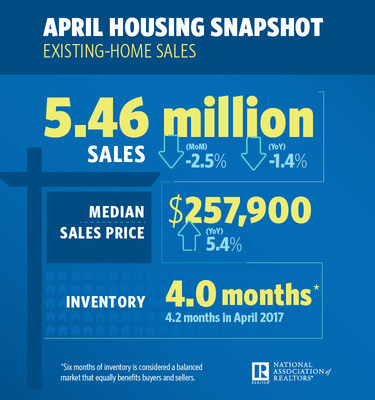Subjects: NPT, SLS, ECO
Existing-Home Sales Slide 2.5 Percent in April
WASHINGTON, May 24, 2018 /PRNewswire/ -- After moving upward for two straight months, existing-home sales retreated in April on both a monthly and annualized basis, according to the National Association of Realtors®. All four major regions saw no gain in sales activity last month.

Total existing-home sales1, https://www.nar.realtor/existing-home-sales, which are completed transactions that include single-family homes, townhomes, condominiums and co-ops, decreased 2.5 percent to a seasonally adjusted annual rate of 5.46 million in April from 5.60 million in March. With last month's decline, sales are now 1.4 percent below a year ago and have fallen year-over-year for two straight months.
Lawrence Yun, NAR chief economist, says this spring's staggeringly low inventory levels caused existing sales to slump in April. "The root cause of the underperforming sales activity in much of the country so far this year continues to be the utter lack of available listings on the market to meet the strong demand for buying a home," he said. "Realtors® say the healthy economy and job market are keeping buyers in the market for now even as they face rising mortgage rates. However, inventory shortages are even worse than in recent years, and home prices keep climbing above what many home shoppers are able to afford."
The median existing-home price2 for all housing types in April was $257,900, up 5.3 percent from April 2017 ($245,000). March's price increase marks the 74th straight month of year-over-year gains.
Total housing inventory3 at the end of April increased 9.8 percent to 1.80 million existing homes available for sale, but is still 6.3 percent lower than a year ago (1.92 million) and has fallen year-over-year for 35 consecutive months. Unsold inventory is at a 4.0-month supply at the current sales pace (4.2 months a year ago).
Properties typically stayed on the market for 26 days in April, which is down from 30 days in February and 29 days a year ago. Fifty-seven percent of homes sold in April were on the market for less than a month.
"What is available for sale is going under contract at a rapid pace," said Yun. "Since NAR began tracking this data in May 2011, the median days a listing was on the market was at an all-time low in April, and the share of homes sold in less than a month was at an all-time high."
Realtor.com®'s Market Hotness Index, measuring time-on-the-market data and listings views per property, revealed that the hottest metro areas in April were Midland, Texas; Boston-Cambridge-Newton, Mass.; San Francisco-Oakland-Hayward, Calif.; Columbus, Ohio; and Vallejo-Fairfield, Calif.
According to Freddie Mac, the average commitment rate for a 30-year, conventional, fixed-rate mortgage increased for the seventh straight month to 4.47 percent in April (highest since 4.49 percent in September 2013) from 4.44 percent in March. The average commitment rate for all of 2017 was 3.99 percent.
"With mortgage rates and home prices continuing to climb, an increase in housing supply is absolutely crucial to keeping affordability conditions from further deterioration," said Yun. "The current pace of price appreciation far above incomes is not sustainable in the long run."
First-time buyers were 33 percent of sales in April (highest since last July), which is up from 30 percent last month but down from 34 percent a year ago. NAR's 2017 Profile of Home Buyers and Sellers ? released in late 20175 ? revealed that the annual share of first-time buyers was 34 percent.
"Especially with mortgage rates going up in recent weeks, prospective buyers should visit with more than one lender to ensure they are getting the lowest rate possible," NAR President Elizabeth Mendenhall, a sixth-generation Realtor® from Columbia, Missouri and CEO of RE/MAX Boone Realty. "Receiving a rate quote from multiple lenders could lead to considerable savings over the life of the loan. Ask a Realtor® for a few recommendations of lenders to contact to get a quote."
All-cash sales were 21 percent of transactions in April, which is up from 20 percent in March and unchanged from a year ago. Individual investors, who account for many cash sales, purchased 15 percent of homes in April (unchanged from last month and a year ago).
Distressed sales5 ? foreclosures and short sales ? were 3.5 percent of sales in April (lowest since NAR began tracking in October 2008), down from 4 percent last month and 5 percent a year ago. Three percent of April sales were foreclosures and 0.5 percent were short sales.
Single-family and Condo/Co-op Sales
Single-family home sales declined 3.0 percent to a seasonally adjusted annual rate of 4.84 million in April from 4.99 million in March, and are 1.6 percent below the 4.92 million sales pace a year ago. The median existing single-family home price was $259,900 in April, up 5.5 percent from April 2017.
Existing condominium and co-op sales increased 1.6 percent to a seasonally adjusted annual rate of 620,000 units in April (unchanged from a year ago). The median existing condo price was $242,500 in April, which is 3.4 percent above a year ago.
Regional Breakdown
April existing-home sales in the Northeast fell 4.4 percent to an annual rate of 650,000, and are 11.0 percent below a year ago. The median price in the Northeast was $275,200, which is 2.8 percent above April 2017.
In the Midwest, existing-home sales were at an annual rate of 1.29 million in April (unchanged from March), and are 3.0 percent below a year ago. The median price in the Midwest was $202,100, up 4.6 percent from a year ago.
Existing-home sales in the South decreased 2.9 percent to an annual rate of 2.33 million in April, but are still 2.2 percent above a year ago. The median price in the South was $227,600, up 3.9 percent from a year ago.
Existing-home sales in the West declined 3.3 percent to an annual rate of 1.19 million in April, and are 0.8 percent below a year ago. The median price in the West was $382,100, up 6.2 percent from The National Association of Realtors® is America's largest trade association, representing 1.3 million members involved in all aspects of the residential and commercial real estate industries.
NOTE: For local information, please contact the local association of Realtors® for data from local multiple listing services. Local MLS data is the most accurate source of sales and price information in specific areas, although there may be differences in reporting methodology.
1Existing-home sales, which include single-family, townhomes, condominiums and co-ops, are based on transaction closings from Multiple Listing Services. Changes in sales trends outside of MLSs are not captured in the monthly series. NAR rebenchmarks home sales periodically using other sources to assess overall home sales trends, including sales not reported by MLSs.
Existing-home sales, based on closings, differ from the U.S. Census Bureau's series on new single-family home sales, which are based on contracts or the acceptance of a deposit. Because of these differences, it is not uncommon for each series to move in different directions in the same month. In addition, existing-home sales, which account for more than 90 percent of total home sales, are based on a much larger data sample ? about 40 percent of multiple listing service data each month ? and typically are not subject to large prior-month revisions.
The annual rate for a particular month represents what the total number of actual sales for a year would be if the relative pace for that month were maintained for 12 consecutive months. Seasonally adjusted annual rates are used in reporting monthly data to factor out seasonal variations in resale activity. For example, home sales volume is normally higher in the summer than in the winter, primarily because of differences in the weather and family buying patterns. However, seasonal factors cannot compensate for abnormal weather patterns.
Single-family data collection began monthly in 1968, while condo data collection began quarterly in 1981; the series were combined in 1999 when monthly collection of condo data began. Prior to this period, single-family homes accounted for more than nine out of 10 purchases. Historic comparisons for total home sales prior to 1999 are based on monthly single-family sales, combined with the corresponding quarterly sales rate for condos.
2 The median price is where half sold for more and half sold for less; medians are more typical of market conditions than average prices, which are skewed higher by a relatively small share of upper-end transactions. The only valid comparisons for median prices are with the same period a year earlier due to seasonality in buying patterns. Month-to-month comparisons do not compensate for seasonal changes, especially for the timing of family buying patterns. Changes in the composition of sales can distort median price data. Year-ago median and mean prices sometimes are revised in an automated process if additional data is received.
The national median condo/co-op price often is higher than the median single-family home price because condos are concentrated in higher-cost housing markets. However, in a given area, single-family homes typically sell for more than condos as seen in NAR's quarterly metro area price reports.
3Total inventory and month's supply data are available back through 1999, while single-family inventory and month's supply are available back to 1982 (prior to 1999, single-family sales accounted for more than 90 percent of transactions and condos were measured only on a quarterly basis).
4Survey results represent owner-occupants and differ from separately reported monthly findings from NAR's Realtors®Confidence Index, which include all types of buyers. Investors are under-represented in the annual study because survey questionnaires are mailed to the addresses of the property purchased and generally are not returned by absentee owners. Results include both new and existing homes.
5Distressed sales (foreclosures and short sales), days on market, first-time buyers, all-cash transactions and investors are from a monthly survey for the NAR's Realtors® Confidence Index, posted at nar.realtor.
NOTE: NAR's Pending Home Sales Index for April is scheduled for release on May 31, and Existing-Home Sales for May will be released June 20; release times are 10:00 a.m. ET.
Information about NAR is available at www.nar.realtor. This and other news releases are posted in the newsroom under the "About NAR" tab. Statistical data in this release, as well as other tables and surveys, are posted in the "Research and Statistics" tab.


SOURCE National Association of Realtors
These press releases may also interest you
|
News published on and distributed by:



